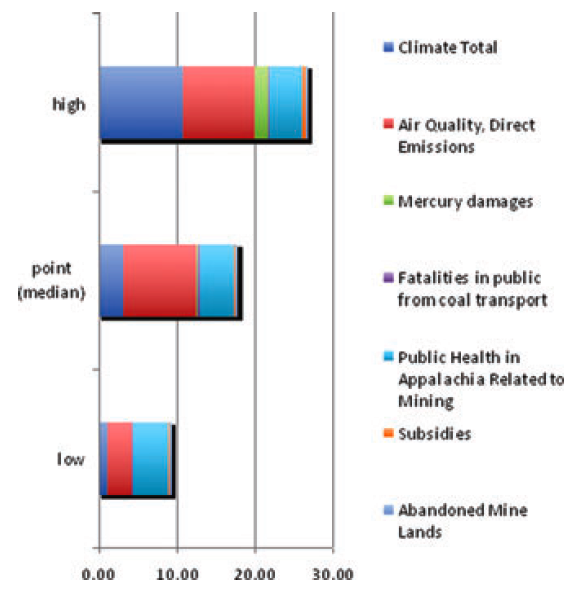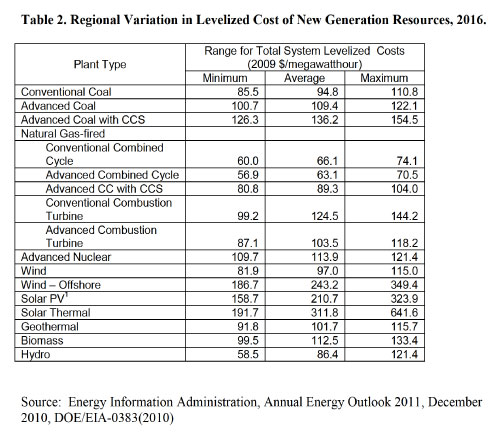The True Cost of Coal Power
Posted on 18 March 2011 by dana1981
Due to its abundance and low market price, coal combustion is the largest source of energy production in the world, accounting for 40% of all electricity worldwide. In the USA it accounts for 45% of electricity generation, and approximately 75% in Australia.
Unfortunately, coal combustion is a major contributor to global greenhouse gas emissions as well, accounting for 30% of total anthropogenic carbon dioxide (CO2) emissions worldwide, and 72% of CO2 emissions from global power generation. In addition, non-power generation uses increase its contribution to global human CO2 emissions to a whopping 41% (as of 2005).
Coal Externalities
A major problem with coal is that its full costs are not reflected in its market price, and thus while we may seemingly purchase and burn coal cheaply, in reality we are paying a much higher cost in the long run, if we look at the big picture. Economists refer to the impacts on human and environmental health which are not reflected in the price of coal as "externalities". Those who benefit from the seemingly cheap electricity don't pay for these externalities directly, but the public eventually has to pay in the form of medical bills, environmental cleanups, etc.
In a new report published in the Annals of the New York Academy of Sciences, Epstein et al. (2011) do a full cost accounting for the life cycle of coal, taking these externalities into account. Among the factors included in this analysis were:
- government coal subsidies
- increased illness and mortality due to mining pollution
- climate change from greenhouse gas emissions
- particulates causing air pollution
- loss of biodiversity
- cost to taxpayers of environmental monitoring and cleanup
- decreased property values
- infrastructure damages from mudslides resulting from mountaintop removal
- infrastructure damage from mine blasting
- impacts of acid rain resulting from coal combustion byproducts
- water pollution
Note that most of these external factors do not apply to most non-fossil fuel energy sources. The majority of the externality costs come from reduction in air quality, contribution to climate change, and impacts to public health. Epstein et al. find that the total cost of these externalities ranges from approximately 9 to 27 cents per kilowatt-hour (kWh) of electricity generated, with a median of approximately 18 cents per kWh. The authors note that this is a conservative estimate, because they have not accounted for every associated impact.

Figure 1: Coal externalized cost (cents per kWh) from Epstein et al. (2011)
Cost Comparison
The US Energy Information Administration provides a comparison of levelized costs for different power generation sources. Levelized cost represents the present value of the total cost of building and operating a generating plant over a period of time, and reflects overnight capital cost, fuel cost, operation and maintenance costs, financing costs, and an assumed utilization rate for each plant type. To convert from dollars per megawatt-hour to cents per kWh, move the decimal point in the table below one spot to the left (for example, conventional coal is 9.48 cents per kWh on average).

As you can see, the externalities are sufficient to triple the cost of coal power, if they were reflected in its price. If we include the coal externalities, it increases the levalized costs to approximately 28 cents per kWh, which is more than hydroelectric, wind (onshore and offshore), geothermal, biomass, nuclear, natural gas, solar photovoltaic, and on par with solar thermal (whose costs are falling rapidly). Suddenly coal doesn't look like such a good deal.
Recommendations
Epstein et al. conclude by offering a number of recommendations:
- Comprehensive comparative analyses of life cycle costs of all electricity generation technologies and practices are needed to guide the development of future energy policies.
- Begin phasing out coal and phasing in cleanly powered smart grids, using place-appropriate alternative energy sources.
- A healthy energy future can include electric vehicles, plugged into cleanly powered smart grids; and healthy cities initiatives, including green buildings, roof-top gardens, public transport, and smart growth.
- Alternative industrial and farming policies are needed for coal-field regions, to support the manufacture and installation of solar, wind, small-scale hydro, and smart grid technologies. Rural electric co-ops can help in meeting consumer demands.
- We must end mountaintop removal (MTR) mining, reclaim all MTR sites and abandoned mine lands, and ensure that local water sources are safe for consumption.
- Funds are needed for clean enterprises, reclamation, and water treatment.
- Fund-generating methods include: maintaining revenues from the workers’ compensation coal tax;
b. increasing coal severance tax rates;
c. increasing fees on coal haul trucks and trains;
d. reforming the structure of credits and taxes to remove misaligned incentives;
e. reforming federal and state subsidies to incentivize clean technology infrastructure. - To transform our energy infrastructure, we must realign federal and state rules, regulations, and rewards to stimulate manufacturing of and markets for clean and efficient energy systems. Such a transformation would be beneficial for our health, for the environment, for sustained economic health, and would contribute to stabilizing the global climate.
Bottom Line
Ultimately it's a significant problem that we rely so heavily on coal to meet our energy needs due to its artificially low market price. It's like eating junk food for every meal. It's cheap, it tastes good, but it's not healthy and eventually you'll pay the price through poor health, high medical bills, and a shortened lifespan.
We may not pay the costs of climate change, lost biodiversity, air and water pollution, adverse health effects, etc. up front, but we do have to pay them eventually. We need to follow the recommendations of Epstein et al., transform our energy infrastructure, and move away from our dependence on coal and other fossil fuels.
Coincidentally, the US EPA has just proposed national standards for mercury, arsenic and other toxic air pollution from power plants. These standards will "require many power plants to install widely available, proven pollution control technologies to cut harmful emissions of mercury, arsenic, chromium, nickel and acid gases, while preventing as many as 17,000 premature deaths and 11,000 heart attacks a year." This is a good step in ensuring that some of the externalities discussed in this article are internalized and taken into account. Coal power plants were exempted from meeting the requirements of the Clean Air Act until 2000, and these new EPA standards will finally ensure that air pollution from coal power plants is regulated, rather than being freely released into the atmosphere.































 Arguments
Arguments






























One of the favorite things to say is "the wind doesn't always blow" so we need to burn coal. Refer those who say that to this item: http://news.sciencemag.org/sciencenow/2010/04/east-coast-winds-would-support-a.html etoc. It shows that if distributed over a reasonably wide area and tied together in a grid, the wind power never goes to zero. In fact, offshore wind farms in the Atlantic could supply all the electrical needs of the coastal states, or more.
[DB] Fixed & hotlinked URL.
A very good article and a good discussion. Do you know how the coal plant prices were calculated? Does the calculation include the cost of building the plant and associated transmission or does it assume the plant is in place? Do the renewable prices include the initial hardware costs?
There are externalities for renewable energy sources also.
One can always find things to add or take awy from an analysis like this. However, the conclusions usually stand when most of the factors are included like this study.
In my oppinion any utility executive promoting a new coal fired plant should be removed for obvious incompetatance. Does anyone think a new plant will ever be profitable when it's expected useful life is probably less than a decade.
Now that this is real, the co op rural movement is where I'm at. Sustainable farming is the name of the game. How do we power a sustainable farming indoor vertical growing system? We have no coal power come next month. Our only means of power generation is oil, natural gas, and gasoline. Air power and solar are not options. We don't have hydrogen systems and the Nitinol engine doesn't exist here yet. We have no rivers so to speak, and no alternatives that will provide the megawatts we need for our communities. I'm tempted to go back to coal or using biomass burnable products that are comparable. Anyone have a suggestion? Oil is abundant. We can burn crude oil by the thousands of barrels and not put a ding into production one bit.
Thanks!
Laughing Man
If you are using up a finite resource, then you dont have "sustainable farming" without using a definition of "sustainable" that would differ a long way from any conventional usage. Why is solar not an option? What part of the world is this?